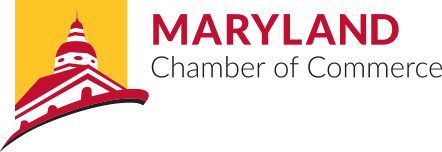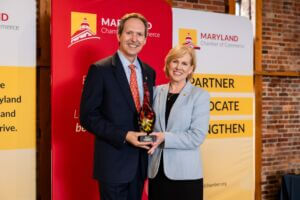Blog
Our New Mission and Vision for the Future: A Q&A with President & CEO Mary D. Kane
Apr 5, 2023
As the leading, unified voice of the Maryland business community, each of us at the Maryland Chamber of Commerce is deeply committed to the success of our great state.
We want to see a Maryland where all businesses and their communities thrive — after all, successful businesses, vibrant communities and wonderful people are what makes our state so unique.
But to make this vision a reality, we must make Maryland better for business. After all, business is what drives our economy, what supports our residents and families, and what plays a huge role in bettering our communities.
With this vision in mind, the staff and Board of Directors at the Maryland Chamber of Commerce recently updated our mission and completed a new strategic plan, which will guide our approach, priorities and work for the next three years.
We sat down with President & CEO Mary D. Kane to discuss the new mission, strategic plan, and what she envisions for the future.
Q: What is the Maryland Chamber of Commerce’s new mission — and how does it expand upon and better define the important work of the Chamber?
A: Our new mission is one sentence — short and precise — we want to advance inclusive partnerships for a Maryland where all businesses and their communities thrive.
Part of our job is to connect business leaders and policymakers across the state, and to use our resources, advocacy and network-building to grow jobs and make Maryland more nationally competitive.
But we do not just connect businesses with policymakers — we highlight the great things strong businesses do for their communities and the economy in Maryland. The Maryland Chamber of Commerce represents a network of 6,800 members that range from the largest Fortune 100 companies to the local towing company. It is this network that supports our schools, our museums, our non-profits, our state and local governments and our residents through taxes that support important infrastructure, education and programs, our successful businesses provide jobs for our residents and important services and products that people rely upon.
Q: How does the success of the business community impact the success of Maryland and its communities?
A: Businesses are what fuel the economy — a successful business community means that more businesses are thriving, leading to more job opportunities, higher wages, and increased economic activity. This, in turn, can lead to an increase in tax revenue for the state, which can be used to fund important public services and infrastructure projects.
Successful businesses also help to create a sense of place, improve the quality of life and create a stable environment for residents and entrepreneurs. This drives more people to want to live, work and own a business in our communities and state, leading to a growing economy and new investments that can lead to innovation and growth.
Business and industry also play an important role in supporting the communities they serve, through volunteer programs, philanthropic giving, innovative employee benefits, resources programs and more. The businesses in our community are the very people who sponsor little league teams, who donate time and money to improve community gathering spaces and who provide job training, educational opportunities and helpful resources to community members.
Q: Why are you so passionate about advocating for Maryland’s business community?
A: Without a thriving business community, we cannot have sustainable, growing communities.
Everyone has heard the stories about cities and states where businesses have left — such as Detroit, MI. While local government of course remained in Detroit, businesses left — and that meant jobs for residents went with them. That left the city without the tax revenue needed to maintain schools, roads, and other important services and infrastructure that people depend upon.
When Detroit looked to rebuild, they looked to businesses, specifically entrepreneurs, to do so. They knew what we know: a thriving business community is the key to having a thriving community. But they also realized, after hard lessons learned, that raising taxes and implementing onerous regulations on businesses is not the way to grow thriving communities. In fact, it proved the very opposite.
I’m passionate about the fact that Maryland should and can have a thriving business community. We need to create pathways and policies that help attract businesses, that help them grow, and that encourage their investment in Maryland. If we make it easier for businesses to be successful, Maryland will be stronger and better for all.
Q: The strategic planning process can be laborious, but often brings about excitement about what’s ahead. As you launch the MDCC’s new mission and strategic plan, what are you most excited about? What are some of the projects/initiatives that came out of the strategic planning process that you are most excited about?
A: I am excited about the new possibilities for Maryland.
In January, we welcomed the Moore-Miller administration and also saw a 50% turnover in the General Assembly. We look at this change in state leadership as an opportunity to stress — the importance of a thriving business community. Our strategic plan lays out the roadmap we will use to advocate for our members and for a strong business community in Maryland.
While there are a number of new initiatives that will come out of the plan, there is one that I am very excited about — our newly published 2023 Competitiveness Redbook for Maryland. The Redbook presents key indicators of Maryland’s business climate. It is a data-driven snapshot of Maryland’s economic health by comparing our state to the rest of the nation in a variety of key indicators of competitiveness including employment growth, cost of education, wages, taxation and economic, fiscal and regulatory freedom. This is a publication we will produce annually and use to share key insights, trends and whether or not we are progressing in a positive direction or regressing in competitiveness.
There’s much more to come, of course, and I am very proud of where we are heading.
Learn more about the Maryland Chamber of Commerce’s new mission and strategic plan


Why Businesses Like Yours Trust Us to Deliver Results